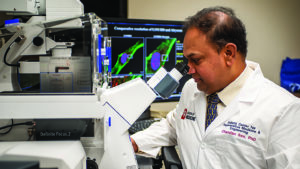
A healing protein that is active in fetuses, but largely inactive in adults and absent in diabetic adults, could be the key to improving treatment of diabetic wounds.
Indiana University researchers noted that the oxidant stress sensor protein, nonselenocysteine-containing phospholipid hydroperoxide glutathione peroxidase, or NPGPx, can repair skin while a baby is in the womb, but it becomes mostly inactive after birth.
“Nature essentially hides this fetal regenerative repair pathway in the adult body,” said Chandan K. Sen, (left) PhD, associate vice president of military and applied research, director of the Indiana Center for Regenerative Medicine and Engineering at the Indiana University School of Medicine. “We spotted its absence, and then activated it to improve healing of diabetic wounds.”
Researchers used tissue technology developed by other engineering faculty to deliver the enhanced healing protein to a wound site. They reported in Molecular Therapy that the targeted lipid nanoparticle delivery of the NPGPx was sufficient “to overcome the deleterious effects of diabetes on this specific pathway to enhance tissue repair.”
From the December 2022 Issue of McKnight's Long-Term Care News




